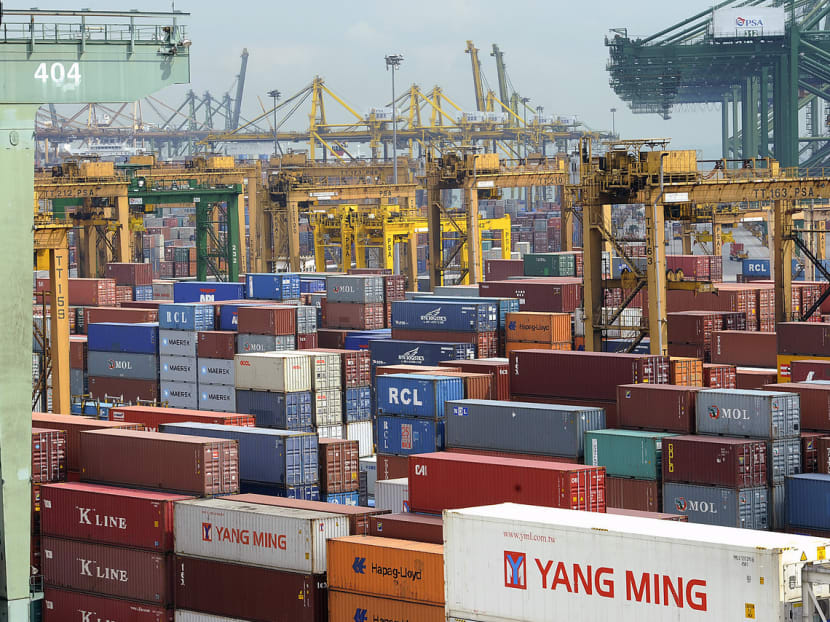S’pore industrial production rises for 3rd month in a row
SINGAPORE — Factory output rose for the third consecutive month in May, albeit at a slower pace than April, boosted by a continued surge in pharmaceuticals and semi-conductors. But analysts caution that a continued positive momentum could be a challenge to achieve, particularly after the Brexit vote yesterday.

Containers are stacked at the Keppel Container Terminal. Industrial production grew 0.9 per cent year-on-year last month. Photo: Bloomberg
SINGAPORE — Factory output rose for the third consecutive month in May, albeit at a slower pace than April, boosted by a continued surge in pharmaceuticals and semi-conductors. But analysts caution that a continued positive momentum could be a challenge to achieve, particularly after the Brexit vote yesterday.
Industrial production grew 0.9 per cent year-on-year last month, showed data from the Economic Development Board (EDB), compared with April’s revised 3 per cent increase.
“Any budding sign of recovery from industrial production got nipped in the bud with the Brexit announcement. If not for the Brexit, we would actually see light in Singapore for the manufacturing sector due to a turnaround led by biomedicals. With Brexit, the positive reading is pushed down as uncertainty lurks and there is a possibility of lower demand coming from the European Union,” said CIMB Private Banking economist Song Seng Wun.
Last month, biomedical manufacturing output expanded 13.2 per cent, slowing slightly from April’s 15 per cent growth. The pharmaceuticals segment jumped 14.2 per cent, while the medical technology segment also saw an increase of 9.2 per cent due to the higher export demand for medical devices.
“The pharmaceuticals and biomedical manufacturing sectors are typically very volatile due to the nature of the industry. Manufacturing output depends on which stage the lifecycle of the pharma products are at during the month. If you exclude biomedical production, Singapore’s manufacturing output fell 2.3 per cent year-on-year,” said Mr Bernard Aw, market strategist at IG. “The weak global outlook means that the higher output of semiconductors may lose steam in the coming months, although the electronics cluster as a whole grew 5.3 per cent year-on-year in the first five months of 2016. The stagnant growth in the US semi book-to-bill ratio is also indicative of a sluggish growth in semiconductor demand ahead.”
The electronics cluster took a hit last month, with growth slowing to 5.9 per cent last month, from 11.1 per cent in April. The semi-conductor segment continued to perform well, with 16.6 per cent growth, however, this was much slower than April’s 24.5 per cent expansion. On a month-on-month and seasonally adjusted basis, manufacturing output shrank 0.4 per cent.
Notable weakness also remains across the transport engineering, especially marine and offshore, precision engineering, general manufacturing, and chemical industries, pointed out Ms Selena Ling, head of treasury research and strategy at OCBC.
“Total manufacturing output grew by a tepid but positive 0.5 per cent year-on-year for the first five months of this year, but the underlying strength excluding biomedical was much weaker at minus 3.6 per cent. As such, can manufacturing output, mainly driven by biomedical, sustain into the second half of 2016 and eke out positive growth momentum for the full-year 2016? (This) remains unclear for now,” she said.
UOB economist Francis Tan also pointed to uncertainty created by Brexit: “Singapore’s manufacturing landscape may be looking uncertain once again as the latest news of the UK exit from European Union membership put many questions into the minds of consumers, corporates and investors alike. Singapore’s total exports to the UK, at US$1.9 billion (S$2.7 billion), were only 0.8 per cent of total exports to the world (at US$238 billion) in 2015. As such, the negative impact to our overall economy via the trade channel may not be too large or immediate in relative terms. However, we are concerned about the impact on trading companies/manufacturers with a larger portion of their revenue from trading with the UK.”
Summing it up, Dr Tan Khay Boon, senior lecturer at SIM Global Education, said: “The marginal increase in manufacturing output year-on-year and a small decrease in the output month-on-month show that the manufacturing sector is not out of the woods yet.
“The small improvement is mainly contributed by the biomedical manufacturing cluster. However, the pharmaceuticals segment is notoriously volatile, hence sustainability is an issue unless there is a stronger boost from the more promising medical technology segment. With no strong rebound of oil prices in sight, the transport engineering cluster will continue to under-perform. It is also being dragged down by a contraction in the marine and offshore engineering segment.
“This cluster can only depend on the aerospace segment, which benefits from low fuel costs. There is also no clear improvement in the performance of the electronics cluster. The prospects for the manufacturing sector appear to be dim.”





